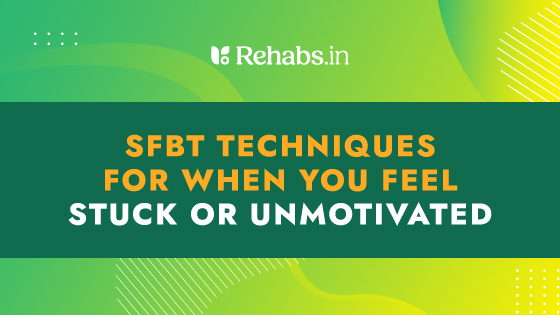SFBT Techniques for When You Feel Stuck or UnmotivatedAuto Draft

We all feel stuck sometimes. Whether it’s getting out of bed, starting a task, or just finding the energy to care, it can feel like we’re frozen in place. Motivation doesn’t always show up when we need it most.
In those moments, it’s easy to focus on everything that’s not working. We often look at the whole mountain of tasks and feel overwhelmed. It can lead to all-or-none thinking, either we do everything perfectly, or we do nothing at all. That pressure can leave us feeling even more stuck.
But what if, instead of aiming for a perfect outcome, we shifted our attention to just one small step forward? Breaking things down into smaller, more doable parts can help us build momentum, slowly but surely.
That’s where Solution-Focused Brief Therapy (SFBT) can help. SFBT is a short-term, goal-oriented approach that focuses on solutions, not problems. Instead of digging into why we feel stuck, it helps us explore what might make things a little better (de Shazer et al., 2007).
Research shows that SFBT can be effective in increasing motivation, building hope, and improving mood, even in short sessions (Franklin et al., 2017). And you don’t need to be in therapy to try some of its tools.
What Is SFBT (and Why It Works When You’re Stuck)
Solution-Focused Brief Therapy (SFBT) is a type of talk therapy that focuses on what’s working, rather than what’s not. Instead of analyzing the problem in detail, it helps you explore your strengths, past successes, and small changes that can make things better.
SFBT was developed in the 1980s by Steve de Shazer and Insoo Kim Berg. They noticed that clients often improved when they were encouraged to focus on their goals and the resources they already had (de Shazer et al., 2007). The approach is future-focused, practical, and often short-term.
One reason SFBT works so well when you feel stuck is that it avoids overwhelming you. Instead of asking why you feel unmotivated, it gently asks, “What would a small improvement look like?” It shifts your attention from feeling helpless to identifying possibilities.
Research shows that SFBT can increase hope, improve mood, and support change even in just a few sessions (Franklin et al., 2017). It’s been used successfully with people facing depression, burnout, and low motivation (Kim & Franklin, 2009).
The Miracle Question
One of the most well-known techniques in SFBT is the Miracle Question. It gently helps you imagine what life could look like if things got even a little bit better. Here’s how it goes:
“Suppose tonight, while you were sleeping, a miracle happened. When you wake up tomorrow, things are different but because you were asleep, you don’t know a miracle has happened. What’s the first small sign that would tell you things have improved?”
Write your own version of a “miracle morning.” What would you be doing differently? How would you feel? Who would notice the change?
Pick one small thing from that imagined morning that you can try today. It could be as simple as making your bed, stepping outside for a few minutes, or replying to one message you’ve been avoiding.
This question shifts your focus from what’s wrong to what could be right. It invites you to picture a better version of your day even if it’s just 5% better. When you’re feeling stuck or unmotivated, it can be hard to know where to begin. The Miracle Question gives your mind a gentle nudge toward hope. It helps you connect with your goals and values, even if you’re not ready to act on them just yet.
Scaling It Down: Progress, Not Perfection
When you’re low on energy or motivation, everything can feel like too much. In SFBT, scaling questions are used to make things feel more manageable. Here’s how you do it:
You rate how you’re feeling or how you’re doing on a scale from 1 to 10.
- 1 means “I feel completely stuck.”
- 10 means “I’m at my best and everything’s flowing.”
Now ask yourself, “Where am I today on this scale?”
Maybe you’re at a 2. That’s okay. The next question is what makes this approach powerful: “What would a 3 look like?”
Draw a simple 1–10 scale in your notebook. Mark where you are today. Then write down one tiny thing you could do to move just one number up. Check in with this scale every few days. You might be surprised to see how small actions add up.
This small shift, from a 2 to a 3, is where progress begins. You’re not trying to jump to 10. You’re just asking what one small step forward might be.
This takes off the pressure to be perfect and helps you notice any movement, no matter how small. Research shows that even small improvements in perceived control can boost motivation and well-being (Bandura, 1997).
Do the Next Tiny Thing
When we’re stuck, even simple tasks can feel overwhelming. Our minds tend to lump everything together into one giant, stressful to-do list. This can lead to avoidance, procrastination, or the classic all-or-none thinking. That’s why breaking things into small, doable steps can make a big difference.
Instead of saying, “I need to finish this report,” try, “I’ll just open the file and write the first sentence.” Instead of “clean the whole house,” try “clear one shelf.” These smaller steps feel more manageable and starting is often the hardest part.
Write down the task that feels too big. Now break it down into the smallest possible action. Set a 5- or 10-minute timer and commit to just that one step. You can even give yourself a small reward for doing the tiny task.
Use the “Sandwich” Technique
Another helpful strategy is pairing effort with comfort. This is often called “sandwiching.” You do a short burst of work → then take a short break or reward → then return to the next bit of work. This not only makes tasks feel less painful, it also gives your brain small rewards that keep motivation alive (Skinner, 1953).
For example,
- Respond to one email → make a cup of tea → respond to one more
- Study for 20 minutes → scroll Instagram for 5 → back to 20 more minutes
Often, we get trapped in a cycle of procrastination: the task feels too big, so we put it off. Then we feel guilty for avoiding it. That guilt drains our energy and turns into self-criticism or shame. Before we know it, the task feels even heavier than before. By taking one tiny step and rewarding yourself for it, you interrupt that cycle. You shift from being stuck in avoidance to building momentum and that shift, however small, matters.
Finding What Works for You
When you’re stuck, it’s easy to think nothing is working. But chances are, there have been moments, even tiny ones, when things felt a little better. Exception-finding is an SFBT technique that helps you notice those moments and learn from them.
Maybe you had a slower morning, talked to a friend, or worked from a café. These small clues tell you what conditions help you function better. Instead of focusing on the problem, you’re looking for patterns in what helps even if only slightly.
Habit-Stacking
Habit stacking means attaching a small action to something you already do. It’s a gentle way to build consistency without needing a big motivation boost. Habit stacking works because it removes the pressure to “start from scratch.” You’re just adding a little shift to what already exists.
For example, “after I make my morning tea, I’ll write down one priority for the day,” “after brushing my teeth, I’ll stretch for 2 minutes,” or “after I check my phone, I’ll take three deep breaths before jumping into work.”
Does Self-Criticism Work as a Motivator?
When you’re feeling unmotivated, it’s tempting to think that being hard on yourself will push you into action. You might say things like, “I’m so lazy,” or “I should be doing more by now.” But research shows that self-criticism often does the opposite, it drains energy, increases shame, and makes it harder to get started (Neff, 2011).
Instead, Solution-Focused Brief Therapy encourages the use of coping questions to gently highlight your strengths. These questions shift your focus from failure to resilience, reminding you that, despite everything, you’re still showing up in small ways. Try asking yourself “how have I managed to get through this so far?”
Pairing this with self-compassion can make a real difference. Studies show that treating yourself with kindness can actually increase motivation and emotional resilience over time (Neff, 2011). When you’re stuck, the most effective next step often begins with gentleness, not guilt.
Keep a “done list” for a few days. Include everything you managed to do, no matter how small. It’s a simple way to notice effort, build momentum, and break free from the lie that you’re doing “nothing.”
Positive Reinforcement
When motivation is low, even the smallest efforts deserve recognition. In SFBT, therapists often highlight a client’s strengths and progress, even when it’s subtle. This isn’t just to be nice, it’s a form of positive reinforcement, and it works.
Our brains are wired to repeat what feels good. So when you notice and reward a helpful action, you’re more likely to do it again. This can be something as simple as saying, “That was tough, and I did it anyway,” or treating yourself to a short break after completing a task.
Do I Need to See a Therapist?
These tools can be powerful, especially when you’re feeling mildly stuck or unmotivated. But if you’ve been feeling low for a long time, struggling to function, or noticing signs of depression or burnout, it might be time to reach out for support.
A mental health professional can help you explore what’s going on beneath the surface and support you in creating lasting change. Therapy offers a safe space to unpack deeper patterns, explore emotions, and build personalized coping strategies that go beyond self-help.
Conclusion
When you’re in a slump, everything can feel heavy. But change doesn’t have to come from a burst of motivation, it can begin with a tiny, gentle shift.
SFBT reminds us that we don’t need to figure everything out. We just need to notice what works, do a little more of it, and build from there. Even the smallest action counts. Even the tiniest step forward matters.
Sources:
Bandura, A. (1997). Self-efficacy: The exercise of control. W.H. Freeman.
de Shazer, S., Dolan, Y., Korman, H., Trepper, T., McCollum, E., & Berg, I. K. (2007). More than miracles: The state of the art of solution-focused brief therapy. Routledge.
Franklin, C., Zhang, A., Froerer, A., & Johnson, S. (2017). Solution-focused brief therapy: A systematic review and meta-summary of process research. Journal of Marital and Family Therapy, 43(1), 16–30. https://doi.org/10.1111/jmft.12102
Kim, J. S., & Franklin, C. (2009). Solution-focused brief therapy in schools: A review of the outcome literature. Children and Youth Services Review, 31(4), 464–470. https://doi.org/10.1016/j.childyouth.2008.10.002
Neff, K. D. (2011). Self-compassion: The proven power of being kind to yourself. HarperCollins.
Skinner, B. F. (1953). Science and human behavior. Macmillan.














